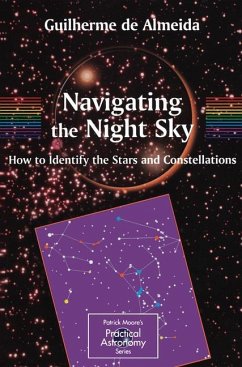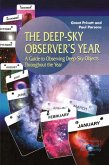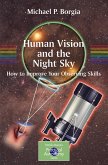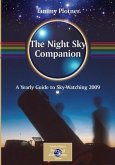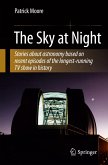This book will interest anyone who marvels at the night sky and would like to learn to recognise constellations and identify the brightest stars by name. Renowned amateur astronomer, Guilherme de Almeida, dispels the myth that specialist knowledge and elaborate instruments are a prerequisite for all astronomical observation. His book emphasizes the point that getting to know the night sky with the naked eye is an essential platform from which to start any astronomical observation. Step-by-step, the reader is guided through the knowledge needed to recognise key constellations, identify stars and planets, and interpret changes in the overall appearance of the sky throughout the year. The text is enhanced by the use of maps and illustrations, making this practical guide an invaluable text for all but the most advanced amateur astronomers.
Onee the Sun has gone down, on clear nights without moonlight, the sky is inhabited by thousands oflumi nous dots of various eolours and levels ofbrightness. The speetacle offered by a starry sky is both grand and sublime, especially in less urban areas. In plaees where night illumination and air pollution are that mueh more intense, it is well known that we are unable to see as many stars as in a rural region. Nevertheless, this need not be overstated: on the out skirts of cities, or even in the cities themselves, pro vided you ehoose the more favourable areas, it is still possible to see many stars. Navigating the Night Sky is aimed at anyone who marvels at the night sky and who wishes to leam to reeognise eonstellations and identify the brightest stars by name. It is essentially a praetieal book, whieh aeeompanies the reader on their eelestial explorations, guiding their way around the stars. Prior knowledge is not required in order to use the book. Anyone ean enjoy it, from the youngest student to the interested adult.
Onee the Sun has gone down, on clear nights without moonlight, the sky is inhabited by thousands oflumi nous dots of various eolours and levels ofbrightness. The speetacle offered by a starry sky is both grand and sublime, especially in less urban areas. In plaees where night illumination and air pollution are that mueh more intense, it is well known that we are unable to see as many stars as in a rural region. Nevertheless, this need not be overstated: on the out skirts of cities, or even in the cities themselves, pro vided you ehoose the more favourable areas, it is still possible to see many stars. Navigating the Night Sky is aimed at anyone who marvels at the night sky and who wishes to leam to reeognise eonstellations and identify the brightest stars by name. It is essentially a praetieal book, whieh aeeompanies the reader on their eelestial explorations, guiding their way around the stars. Prior knowledge is not required in order to use the book. Anyone ean enjoy it, from the youngest student to the interested adult.
From the reviews:
"The author, who is a well-known Portugese amateur astronomer, methodically explains how to recognize the brighter stars and major constellations and, thus, how to find one's way around the night sky. ... This book does an effective job of doing what it sets out to do. I recommend it to anyone who wants to explore the night sky for the first time and understand how the night sky visible to us changes during the night and during the year." (Jocelyn Tomkin, The Observatory, Vol. 125 (1186), 2005)
"The book is about how to identify the stars and constellations ... . This book comprises a nice selection of careful thought out diagrams which fit in beautifully with the text ... . I would really recommend it to someone who is new to astronomy or as a reference book for the regular observer. ... With the aid of this book ... even the newest observer will be off to a flying start. ... The language of the book is easily accessible ... ." (Samuel George, Photopresse, Issue: 44, October, 2004)
"The book is targeted at newcomers to astronomy ... . the book is interesting and accessible, the concepts discussed are easy to understand and the content flows naturally, with chapters on identifying the constellations, stars and the celestial sphere. ... the book closes with 40 pages of appendices with lots of useful tables and data. The diagrams ... are especially clear and concise ... . This book would certainly point the newcomer in the right direction! I would recommend this practical guide ... ." (Mark Allison, Popular Astronomy, July-September, 2006)
"The author, who is a well-known Portugese amateur astronomer, methodically explains how to recognize the brighter stars and major constellations and, thus, how to find one's way around the night sky. ... This book does an effective job of doing what it sets out to do. I recommend it to anyone who wants to explore the night sky for the first time and understand how the night sky visible to us changes during the night and during the year." (Jocelyn Tomkin, The Observatory, Vol. 125 (1186), 2005)
"The book is about how to identify the stars and constellations ... . This book comprises a nice selection of careful thought out diagrams which fit in beautifully with the text ... . I would really recommend it to someone who is new to astronomy or as a reference book for the regular observer. ... With the aid of this book ... even the newest observer will be off to a flying start. ... The language of the book is easily accessible ... ." (Samuel George, Photopresse, Issue: 44, October, 2004)
"The book is targeted at newcomers to astronomy ... . the book is interesting and accessible, the concepts discussed are easy to understand and the content flows naturally, with chapters on identifying the constellations, stars and the celestial sphere. ... the book closes with 40 pages of appendices with lots of useful tables and data. The diagrams ... are especially clear and concise ... . This book would certainly point the newcomer in the right direction! I would recommend this practical guide ... ." (Mark Allison, Popular Astronomy, July-September, 2006)

